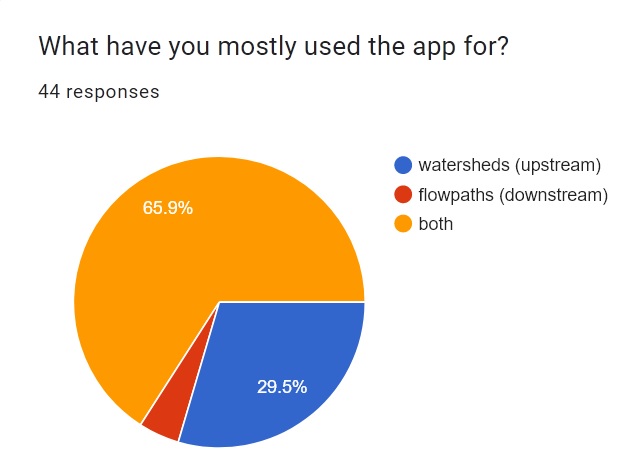Last month, I posted a poll on the Global Watersheds page. The app is getting around 200 users per day, and I was curious to see who is using it and why.
I found out that most of you are just as interested in tracing downstream flowpaths as you are in delineating watersheds. To be honest, I added this feature to the app as a bit of an afterthought.

More detailed flowpaths
Since folks are so interested in downstream flowpaths, I decided to add a couple of new features. You can now use higher-precision mode. (This is enabled by default if you are zoomed in far enough or when you manually enter coordinates).
Previously, the flowpath started at the closest river or stream. Now, the flowpath starts right near the point where you clicked. (Well, starting at the nearest pixel with a downstream neighbor.) The app will trace the flow from the point of origin, going downhill over land until it encounters a stream or river. From there, it flows to the sea or to an inland sink.
Share flowpaths
You can now share or embed your downstream flowpaths. After you’ve created a new flowpath, just click one of the sharing buttons at the left bottom. The link will point to a custom page with your flowpath. To embed a map widget, click the embed button </>, and copy and paste the code into a web page or blog post.
Tracing contaminant flow
Here’s an example of both new features in action. On February 2, 2023, a freight train derailed in East Palestine, Ohio. According to the US Environmental Protection Agency, vinyl chloride and other toxic chemicals were “released to the air, surface soils, and surface waters.”
Based on the EPA reports, the spill occurred at latitude: 40.836° N, longitude: -80.522° W. We can use the Global Watersheds app to find out where water flows downstream from this location. This can help us begin to understand where these chemicals can be transported by water, and what people and ecosystems could be at risk.
As always, if you encounter any bugs using these new features, send me a message!
